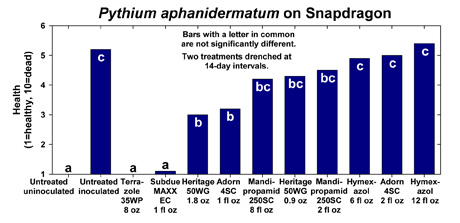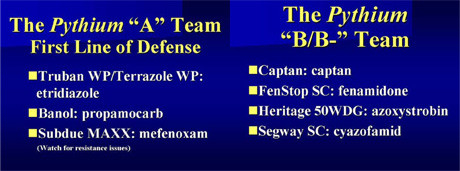Greenhouse disease update for Pythium root rot
Editor’s note: This article is from the archives of the MSU Crop Advisory Team Alerts. Check the label of any pesticide referenced to ensure your use is included.
Pythium crown and root rot is a troubling disease for many growers and at times may seem unavoidable and tough to control. Never underestimate the ability of Pythium to “hang out” in a greenhouse on flats, benches, floors, hoses, etc. Always clean growing surfaces and structures between crops. First, use a pressure washer with soap and water. Second, treat cleaned surfaces with a disinfectant to remove any remaining “unseen” problems such as Pythium. Root rot must be detected and identified early while fungicide drenches can be most effective. If Pythium has a significant head start, the root system of some plants will be too rotted and the fungicide drench won’t be able to rescue them.
If timely fungicide drenches have been made using appropriate rates and root rot continues to be a problem, it is time to take a hard look at the products used. If Subdue MAXX has been the only or primary fungicide used over the years for Pythium control, it is possible that the Pythium has become resistant and is no longer affected by this fungicide. To know for sure, however, the Pythium present in your greenhouse can be tested. Some diagnostic clinics offer this service. To avoid the development of resistance, rotate among the different active ingredients available among fungicide products.
Evaluation of fungicides for the control of Pythium on dwarf snapdragons
Disease severity was severe in this trial with the untreated inoculated plants averaging 2.9 inches in height (untreated uninoculated averaged 5.9 inches) and plant health rating of 5.2 (1 equals healthy, 10 equals plant death) on the last rating date.Untreated inoculated plants slightly recovered from the initial infection between May 23 and June 6.Industry standards Terrazole WP and Subdue MAXX EC were very effective and resulted in plant heights of 5.1 and 5.2 inches, respectively, and were the only treatments significantly taller than the untreated inoculated control on both rating dates.On June 6, Adorn (1 fl oz), Subdue MAXX, Terrazole WP, and Heritage WG (1.8 oz) were the only treatments with plant health ratings significantly better than the untreated control.No phytotoxicity was observed on any of the treated plants in this trial.


Acknowledgements
This research was funded in part by Floriculture Nursery and Research Initiative of the Agricultural Research Service under Cooperative Agreement #59-1907-5-553 and by the American Floral Endowment.

Dr. Hausbeck's work is funded in part by MSU's AgBioResearch.



 Print
Print Email
Email


